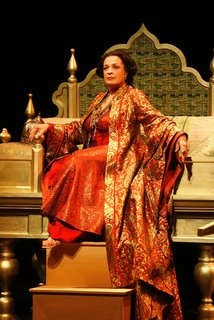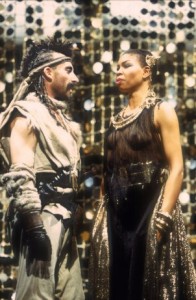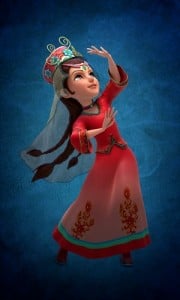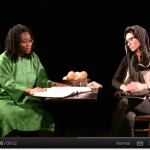The two parts of Christopher Marlowe’s play Tamburlaine, loosely based on the life of the Central Asian emperor Timur the Lame, tell the story of the Scythian shepherd who becomes a conqueror of kings. Although this play was written in the 1588, it gives us an insight into representations of Muslim women at the time of writing, and has some relevance for today, as is evidenced by the proliferation of studies of early modern “Turk” and “Moor” plays. As one review of DC’s Shakespeare Theatre Company’s production puts it:

Tamburlaine’s landscape, brutality, and clash with Moslem countries give currency to today’s American audience who live with involvement in brutal wars in Iraq and Afghanistan that impact relations with Iran and other Moslem countries.
Perhaps the most famous line in Marlowe’s Tamburlaine, “And shall I die and this unconquered?” encapsulates the story of Tamburlaine’s continuously chasing conquest, “Threat’ning the world with high astounding terms/And scourging kingdoms with his conquering sword.” As those conquests sweep from central Asia through Persia to Turkey, the play explores not only issues of ambition and hubris, but also appeals to anti-Turkish sentiments felt around Europe at a time when, as Richard Knolles writes, the Turks had “grown to the height of majesty and power, as that it hath in contempt all the rest.”
One of the most interesting aspects of the play is the utilizing of national anxieties reflected in Tamburlaine’s victory over the Turkish Emperor Bajazeth. While Bajazeth proclaims “Now shalt thou feel the force of / Turkish Arms, /Which lately made all Europe quake for fear,” Tamburlaine asserts, “Tush, Turks are full of brags/And menace more than they can perform.” These dynamics make Tamburlaine a complex text when it comes to the question of how Islam was represented within the human geography of the world on the Renaissance stage, a question which has recently seen a resurgence of interest, but which goes back almost a hundred years to Louis Wann’s ‘The Oriental in Elizabethan Drama’ (1915) and Warner Grenelle Rice’s ‘Turk, Moor, and Persian in English Literature’ (1927).
But Tamburlaine is equally interesting for its construction of gender roles, especially in the first part, given Zenocrate’s transformation from being the daughter of the Sultan and the betrothed of the Prince of Arabia, to being Tamburlaine’s captive, to Queen of Persia. In the beginning, Zenocrate’s speech is a constant reminder of her status, which forms a distinction between her and Bajazeth’s wife, Zabina. As Lamiya Almas points out, while both are captives, “Zabina is an empress by association and not by birth, but Zenocrate, also an empress, is an absolute monarch by birth, and through her marriage Tamburlaine’s territories and hers will be united.”
Soon, Zenocrate begins to compare herself with Juno through her connection with Tamburlaine, retorting: “Call’st thou me concubine, that am betrothed/unto the great and mighty Tamburlaine?” The text seems to offer some autonomy to Zenocrate here, yet this could be seen as underlining Zenocrate’s trophy position. As Mohja Kahf puts it in her book Western representations of the Muslim woman: From Termagant to Odalisque, “Whether wives, mothers, maids or concubines, the women in Tamburlaine are trophies and accessories to men and rarely budge from rather wooden roles.”
There is, however, an openness to other interpretations, depending on whether Zenocrate is portrayed as a dissident voice against violence later on in the play. Some of her lines do conflict with the dominant narrative, in her plea for her father’s kingdom, her grief for the virgins whose execution Tamburlaine orders, and her lament over Bajazeth and Zabina’s suicide. But it could equally be argued that the rise and triumph of Tamburlaine is paralleled by the suppression of Zenocrate, who becomes increasingly silent towards the end of the first part, whether this is interpreted as the “silent treatment” or as Sara Deats sees it, a progression through which Zenocrate, “interpellated into female passivity and silence by the end of Part I, petrifies into the figure of the ideal wife and mother in Part II.”
Is there an aspect of Zenocrate’s portrayal that is specific to the play’s Islamic context? Kahf argues that in fact, Zenocrate’s representation utilizes familiar tropes from the maiden in distress to the loyal wife, which do not relate to “conventional Muslim woman material.”
Just as Tamburlaine is represented in human terms rather than in terms of the literary conventions of the Muslim/pagan Other, Zenocrate, Zabina, their maids, Olympia, the Virgins of Damasucs and the Turkish concubines are represented as a function of the simple difference of female gender and not the complex difference of Islamic Other/female gender.

If this is so, how have recent productions represented this material, given the context of the last two decades, from the rise of the paradigm of the Clash of Civilizations during the 90’s to the War on Terror? In his review of Tamburlaine in performance, David Fuller notes that during the 1990s, productions played up issues of cultural otherness. In Terry Hand’s production, African chants were performed by the group Welcome Msomi, which Fuller notes might not have been the appropriate alien culture but did convey otherness and racial difference, further reinforced through Zenocrate being played by Claire Benedict, who is black. Fuller goes on to note that Bajazeth’s costume included curved flaps on the head that suggested elephant tusks, a use of animalistic imagery that matched the Turks’ elephant-like screaming during their confrontation with Tamburlaine.
In 2005, there was a brief controversy over the climactic Quran burning scene in the second part of the play, which it was claimed, was censored in one production, though the director responded that this was “complete nonsense.”
Tamburlaine did burn the Qur’an centre-stage in an old petrol drum – but I wanted to make it very clear that his act was a giant two fingers to the entire theological system…His act was a hubristic and nihilistic defiant scream at what he saw as an empty universe.
Tamburlaine’s speech during this scene is reminiscent of Zabina’s lament, describing the world bereft of meaning, “Then is there left no Mahomet, no God/No fiend, no Fortune, nor no hope of end/To our infamous, monstrous slaveries.” Bindu Malieckal relates Zabina (perhaps the first Ottoman woman represented on the stage) to her historical counterparts, women such as Nur Banu and Safiye, “Turkish” women of Christian and European origins who were “first and foremost Ottoman agents,” presenting contradictory characteristics, “slaves and queens, Christians and Muslims, European, African, and Ottoman, defeated yet decisive.”
In the play, Zabina is no foil character, but is represented as “a woman with authority and honor” who chooses to commit suicide with her husband rather than continue to be enslaved. In her lament just before her suicide she depicts a hell on earth and a sense of abandonment by faith which reinforces Tamburlaine’s claim to being the scourge of mankind. But the force of the scene becomes clear with Zenocrate’s discovery of their bodies as she reflects:
Wretched Zenocrate! that liv’st to see
Damascus walls dyed with Egyptians’ blood,
Thy father’s subjects and thy countrymen;
Thy streets strowed with dissevered joints of men
And wounded bodies gasping yet for life
Zenocrate’s sympathy for Zabina, turned from “enemy” to “empress,” is a pivotal scene in terms of her character’s development, and its force derives from its break from the play’s dominant ethos of violence, a break which in a sense bring us full circle in its echo of that other famous line of Tamburlaine, spoken early on by the defeated King of Persia: “Accursed be he that first invented war.”











